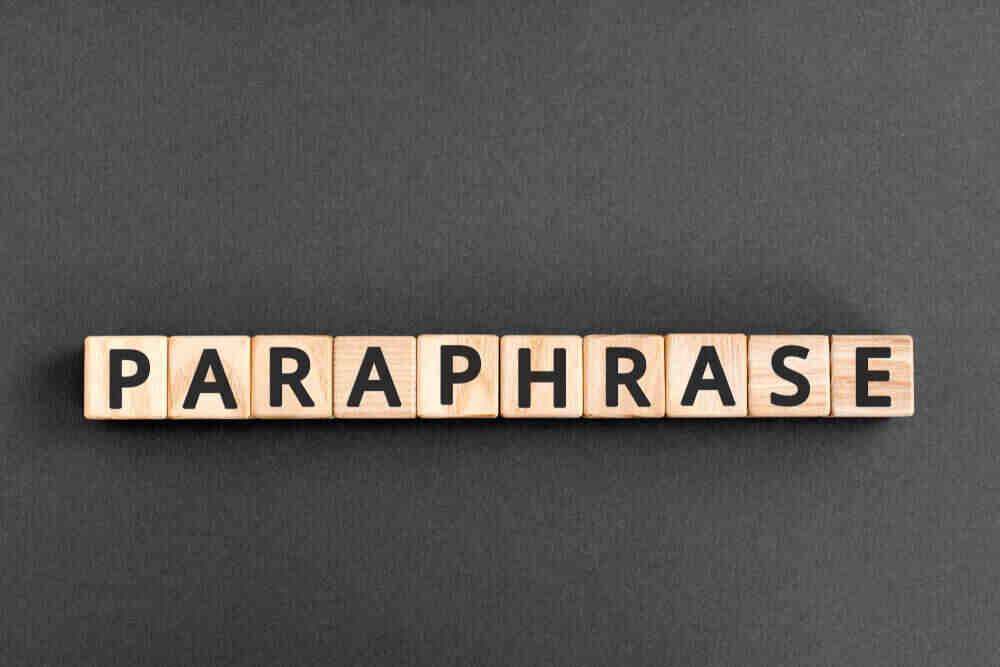Upgrade Your Writing with Top Paraphrasing Tools 2023
Paraphrasing tools can be very helpful for content creators who need to produce original content quickly or for anyone who needs to avoid plagiarism. However, it's always a good idea to review the output of any tool and make necessary edits to ensure the final text is high-quality and accurate.

Paraphrasing is an essential tool for any writer, as it allows you to convey information in your own words while avoiding plagiarism. While it is a valuable skill, it can be time-consuming and challenging, especially when dealing with complex texts. Luckily, there are many paraphrasing tools available that can help streamline the process. In this article, we'll look at the top paraphrasing tools of 2023 and explore how they can help enhance your writing.
Understanding Paraphrasing
Paraphrasing is restating information in your own words while maintaining the original meaning. It is an essential tool for writers as it allows them to avoid plagiarism while conveying important information. Paraphrasing is especially useful when dealing with technical or complex texts that may be difficult to understand.

Top Paraphrasing Tools of 2023
What are the best paraphrasing tools? Many paraphrasing tools are available on the market, each with features and benefits. Some of the most popular tools are mentioned below.
1. Grammarly: AI Paraphrasing Tool
How to use Grammarly paraphrasing tool? Grammarly is an online writing assistant offering various features to help writers improve their writing. In addition to checking for spelling and grammar errors, Grammarly offers a built-in paraphrasing tool that suggests alternative ways to express a given sentence or phrase. This feature can be handy for writers who are looking to improve the clarity and effectiveness of their writing.
One of the benefits of the best free paraphrasing tool, Grammarly, is that it is straightforward to use. The tool can be accessed directly through a web browser or installed as a plugin for popular writing programs like Microsoft Word or Google Docs. Once installed, Grammarly automatically checks for errors as you type, highlighting mistakes and offering suggestions for improvement. Additionally, the tool offers a range of settings that can be customized to fit your writing style, including tone, style, and audience.


While Grammarly's paraphrasing feature is valid, it should be noted that it is not always accurate. This AI-based paraphrasing tool can sometimes suggest awkward or incorrect phrasing, and writers should always review suggested changes before accepting them. Overall, however, Grammarly is the best free paraphrasing tool to avoid plagiarism for anyone looking to improve their writing and avoid common mistakes.
2. QuillBot Paraphrasing Tool
QuillBot is an AI-powered paraphrasing tool that uses machine learning to rewrite the text. The tool is designed to handle complex sentences and technical language, making it an excellent choice for writers dealing with specialized subjects. It can also be used as a thesis paraphrasing tool because of its expertise in remaking academic content.
One of the benefits of the paraphrasing tool QuillBot AI is its versatility. The tool can rephrase entire paragraphs or individual sentences, offering a range of different paraphrasing modes, including fluency and creativity. Additionally, QuillBot offers a built-in grammar checker that can help catch mistakes and improve the overall quality of your writing.
The paraphrasing tool QuillBot is powerful software, but it does have some limitations. The tool can sometimes produce awkward phrasing or incorrect grammar, and it may only sometimes capture the intended meaning of the original text. However, for writers dealing with complex technical language or struggling with writer's block, QuillBot can be a handy tool.
3. Paraphrasing Tool Spinbot
Spinbot, like other paraphrasing tools, is a web-based article-spinning tool that allows users to create unique content from existing articles. The tool replaces words and phrases with synonyms, resulting in a new version of the original text. While article spinning can be a helpful way to create unique content quickly, it is essential to note that spun content can often be low-quality and challenging to read.

One of the benefits of Spinbot is that it is effortless to use. You can access the tool directly through a web browser, and it offers a range of settings that you can customize to fit your needs. Additionally, Spinbot can spin entire articles or individual sentences, giving writers various options for creating unique content.
While Spinbot, a paraphrasing tool like QuillBot, can help create unique content quickly, it is essential to use it responsibly. Spun content is often low-quality and challenging to read, and it may not be suitable for use in professional settings. Additionally, spun content can be considered plagiarism if it is not cited correctly or closely resembles the original text.
4. Prepostseo Paraphrasing Tool
Prepostseo is an online tool offering various features designed to help writers improve their writing. In addition to a paraphrasing tool, Prepostseo also offers a plagiarism checker, grammar checker, and summarizing tool in addition to a paraphrasing tool.
One of the benefits of Prepostseo is that it is incredibly versatile. The tool is helpful for various tasks, including checking for plagiarism, improving grammar and spelling, and summarizing longer texts. Additionally, Prepostseo offers a range of customization options, allowing users to tailor the tool to fit their specific needs.
While Prepostseo is the best AI paraphrasing tool, it can sometimes be challenging. The interface may be cluttered, and some features require experimentation to understand fully. However, once you get the hang of it, Prepostseo can be a handy tool for improving the quality of your writing.
The best paraphrasing tool online offered by Prepostseo is designed to help writers reword text without changing its meaning. The tool offers a range of settings that allow users to customize the level of paraphrasing, from minimal changes to more substantial rewording. Additionally, the tool offers suggestions for improving sentence structure and clarity, making it an excellent choice for writers looking to improve the overall quality of their writing.
The plagiarism checker offered by Prepostseo is also a powerful tool. The tool compares your text to an existing content database, highlighting any areas that may be too similar to other texts. It can be beneficial for writers who are concerned about accidental plagiarism or who want to ensure that their work is original.


Overall, each of these best paraphrasing tools offers unique features designed to help writers improve their writing. While each tool has strengths and weaknesses, they can all be useful for writers looking to create high-quality, engaging content. Whether you're a professional writer or just getting started, these tools can help you take your writing to the next level.
How to Choose the Right Paraphrasing Tool
Paraphrasing is a critical skill for any writer, and paraphrasing tools can be incredibly helpful in ensuring that your writing is clear, concise, and engaging. However, with so many paraphrasing tools available on the market, it can take time to decide which one to choose.
When choosing a paraphrasing tool, it's essential to consider factors such as accuracy, ease of use, and affordability. It's also essential to compare the different tools to find the one that best suits your needs. For example, if you're dealing with technical language, choose a tool like QuillBot, specifically designed to handle complex texts.
1. Determine Your Needs
The first step in choosing the right paraphrasing tool is determining your needs. Are you looking for a tool to help you rephrase sentences and paragraphs, or do you need one to handle more substantial rewrites? Are you primarily concerned with accuracy, or are you more focused on ease of use? By answering these questions, you can narrow down your options and find a tool that meets your specific needs.
2. Consider Your Budget
Another essential factor to consider when choosing a paraphrasing tool is your budget. While many tools are free, others require a subscription or one-time payment. It's essential to consider your budget when choosing a tool, as there may be better choices than the most expensive option for your needs.
3. Look for User-Friendly Features
The best paraphrasing tools are designed to be user-friendly and intuitive, even for those who need to be tech-savvy. Look for tools that offer a simple and easy-to-use interface, clear instructions, and helpful tips. Some tools even offer tutorials or training resources to help you get the most out of their features.

4. Check for Accuracy
Accuracy is one of the most critical factors when choosing a paraphrasing tool. Look for tools that use advanced algorithms and natural language processing to ensure the reworded text is accurate and conveys the same meaning as the original. You may also want to consider tools that offer a "human" touch, such as access to professional writers or editors who can review your text and ensure it is error-free and polished.
5. Read Reviews and Testimonials
One of the best ways to determine the quality of a paraphrasing tool is to read reviews and testimonials from other users. Look for tools with positive reviews and testimonials, and pay attention to comments mentioning specific features or benefits. You can also look for reviews on independent review sites or forums to get a broader perspective on the tool's strengths and weaknesses.
6. Look for Additional Features
While the primary function of a paraphrasing tool is to rephrase text, many tools offer additional features that can be incredibly useful for writers. For example, some tools offer a plagiarism checker to help you ensure that your writing is original and free from duplicate content. Others may offer a grammar or spell checker to help you catch errors and typos. Consider which additional features are most important to you and look for tools that offer them.
7. Check for Customer Support
Finally, when choosing a paraphrasing tool, it's essential to consider the level of customer support offered by the tool's provider. Look for tools that offer prompt and responsive customer support through email, chat, or phone. Consider tools that offer a knowledge base or help center where you can find answers to frequently asked questions or troubleshoot any issues you may encounter.
8. Consider the Language and Style
When choosing a paraphrasing tool, it's essential to consider the language and style you are writing in. Look for tools specifically designed for your target language, whether English, Spanish, or any other language. Additionally, consider the style of writing you are using, such as academic, technical, or creative writing. Some tools may be better suited for certain writing styles than others, so choosing a tool that aligns with your needs is important.

9. Evaluate the Output Quality
When using a paraphrasing tool, it's essential to evaluate the output quality of the tool. Look for tools that produce high-quality, natural-sounding text that is easy to read and understand. It's also important to check the output for accuracy and ensure it conveys the same meaning as the original text. Some tools may produce output that could be smoother or more comfortable, so be sure to test the output quality before committing to a particular tool.
10. Consider the Integration with Other Tools
Finally, it's essential to consider integrating the paraphrasing tool with other tools you may be using for your writing. For example, if you use a grammar checker or writing software, ensure the paraphrasing tool can be easily integrated into your existing workflow. Some tools offer APIs or integrations with popular writing software, making the process of using the tool much more efficient and streamlined.
Choosing the right paraphrasing tool is essential for any writer looking to improve the quality of their writing. By considering your needs, budget, user-friendliness, accuracy, reviews, additional features, and customer support, you can find a creative paraphrasing tool that meets your requirements and helps you create engaging and polished content.
Tips for Effective Paraphrasing
Effective paraphrasing is an essential skill for any writer, whether you are a student, a blogger, or a professional writer. Paraphrasing involves rephrasing the original text in your own words while still conveying the same meaning. While paraphrasing tools can be incredibly useful, using them correctly is essential. Here are some tips for effective paraphrasing:
1. Understand the Original Text
Before you can effectively paraphrase a piece of text, you need to understand the original text. Take the time to read and reread the text, highlighting or taking notes on the key ideas, arguments, and concepts. It will help you identify the most important points in the text and ensure that you capture the essence of the original text in your paraphrase.
2. Use Synonyms and Different Sentence Structures
When using the best tool for paraphrasing, it's important to use synonyms and different sentence structures to convey the same meaning as the original text. It not only helps to avoid plagiarism but also makes your writing more interesting and engaging. Look for synonyms for keywords in the original text and try to rephrase the sentences using different grammatical structures.
3. Keep the Same Tone and Style
While you want to rephrase the original text in your own words, keeping the same tone and style as the original text is important. If the original text is formal and academic, your paraphrase should be too. Likewise, if the original text is informal and conversational, your paraphrase should reflect that. It will help maintain the original text's intended tone and style and ensure that your paraphrase is appropriate for the context.
4. Don't Just Change a Few Words
The best paraphrasing tool involves more than just changing a few words in the original text. To truly paraphrase a piece of text, you need to rephrase the original text to reflect your understanding and interpretation of the text. It means you must use your own words and sentence structures to convey the same meaning as the original text.
5. Use Paraphrasing Tools as a Guide
Paraphrasing tools can be a helpful guide when you're struggling to paraphrase a text. However, using these tools as a guide is important rather than relying on them entirely. Use the top paraphrasing tool to generate a paraphrase, but then take the time to read and revise it to ensure that it accurately reflects the original text and conveys your understanding of the text.
6. Check for Plagiarism
Even if you've done your best to paraphrase a piece of text, it's important to check for plagiarism to ensure that you haven't inadvertently copied too much from the original text. Many plagiarism-checking tools available online, such as Grammarly or Turnitin, can help you check your work and identify any plagiarism.
7. Practice, Practice, Practice
As with any skill, the more you practice paraphrasing, the better you will become. Take the time to practice paraphrasing various texts, from news articles to academic papers, and compare your paraphrases to the original text to see how you did. With practice, you will better understand how to paraphrase text effectively and improve your writing skills.
Effective paraphrasing is an essential skill for any writer. By understanding the original text, using synonyms and different sentence structures, keeping the same tone and style, and practicing regularly, you can improve your paraphrasing skills and avoid plagiarism in your writing.
Is Using A Paraphrasing Tool Cheating?
Paraphrasing is rewording a text to express it differently while preserving its original meaning. In recent years, paraphrasing tools have become increasingly popular among students. However, the question of whether using a paraphrasing tool is cheating or not remains a matter of debate.
1. Using a paraphrasing tool to plagiarize is cheating.
If you are a student using a paraphrasing tool to rephrase someone else's work without giving proper credit, it would be considered cheating and a violation of academic integrity. The offense of plagiarism can have severe consequences, such as failing a course or being expelled from a school. In such cases, it is essential to properly cite the source and use the paraphrasing tool only as a reference, not as a substitute for your work.
2. Using a paraphrasing tool to understand complex concepts is not cheating.
If you use a paraphrasing tool to help you understand complex concepts or rephrase your work, it is not cheating. Paraphrasing tools can be useful in helping you to avoid plagiarism by providing alternative ways to express ideas. In this context, a paraphrasing tool can be a helpful tool to aid your learning process.
3. Paraphrasing tools are not a substitute for critical thinking and writing skills.
It's important to remember that while paraphrasing tools can be helpful, they are not a substitute for your own critical thinking and writing skills. You should always double-check a paraphrasing tool's results and ensure that the rephrased text accurately represents the original idea. Additionally, paraphrasing tools may only sometimes be able to capture the nuances and context of a text, which is where your understanding and interpretation can be valuable.
Conclusion
Paraphrasing is an essential tool for any writer, and it can be made even easier with the help of paraphrasing tools. Choosing the right tool and following best practices for effective paraphrasing can enhance your writing and avoid plagiarism.
Using paraphrasing tools can be considered cheating if it is used to plagiarize someone else's work without proper attribution. However, using a paraphrasing tool to aid in understanding complex concepts is not cheating. Ultimately, the key is to use the tool responsibly and always to ensure that the final product accurately represents the original idea.



